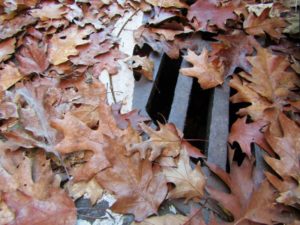
In rural settings, falling rain and melting snow soak into the soil or flow directly into streams and rivers. Eventually, all precipitation percolates into the groundwater supply or flows into the world’s oceans.
In urban settings, stormwater systems are necessary to control and direct runoff from roofs, driveways, sidewalks, parking lots, and other impervious surfaces. These systems are comprised of gutters, ditches, storm drains, and other solutions. Without stormwater systems, flooding, erosion, and water pollution would skyrocket. As a business owner, you are responsible for managing your stormwater system to help prevent these problems as rainwater flows from city streets toward area waterways.
Have you noticed the ditches, storm drains, loading docks, or other low-lying areas on your property starting to flood? Don’t ignore this problem! A backed-up stormwater system could make you lose customers, flood your building, or result in fines from local authorities for causing a health hazard. No matter how you look at it, stormwater system flooding is a messy, expensive problem you want to avoid at all costs.
Here are the top reasons why your stormwater system may be flooding:
- Obstructions in the storm drain: When water flows down the street toward a storm drain, it often carries leaves, twigs, trash, and sediment with it. Without proper maintenance, this debris can clog the storm drain, causing it to become inundated with water when it rains.
- Broken sump pump: Sump pumps are flood prevention devices installed in a sump pit at the lowest point of a building. When rising groundwater fills the pit, the pump turns on and directs the water to another part of the stormwater system. Unfortunately, if the sump pump becomes clogged or stops working properly, flooding could occur.
- Poor site drainage: Certain sites are more susceptible to flooding than others. Improper soil grading, a high water table, and a poorly designed stormwater system are all reasons your site may flood during a torrential downpour.
- Fabric filters left after construction: If your site was recently under construction, the crew may have left fabric filters behind. These are designed to temporarily collect sediment, trash, and other construction-based debris. While useful for their intended purpose, fabric filters left in drains long-term may cause flooding after a significant rain event.
- Neglected stormwater maintenance: Stormwater facilities come in many forms, from above-ground infiltration basins and sand filters to below-ground detention facilities and storm drains. Every type of stormwater device requires maintenance to remove accumulated sediment and other debris. Without proper attention, a stormwater device is likely to become clogged, leading to its eventual failure and flooding during the next rainstorm.
Keep an eye on your stormwater system during heavy rains. If you notice water pooling around the storm drain or in other low-lying areas, it’s time to call Trinity Liquid Waste before a costly flood occurs. Reach us at 510-874-6489 or contact us online today. We are a family-owned company with over 25 years of experience offering stormwater system maintenance in Pleasanton, CA.
““
